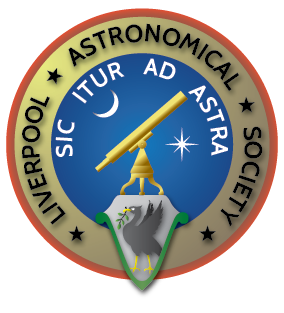Happy Christmas and clear, dark skies for 2000
from all members of Liverpool Astronomical Society
Society News Headlines
- Dec 3rd: Pluto in conjunction with the Sun.
- Dec 3rd: Mercury at greatest elongation (20°W).
- Dec 3rd: Mars Polar Lander Touch-down To-day.
- Dec 3rd: Venus 3° South of Moon.
- Dec 3rd: Public Open Night at The LAS Pex Hill Observatory, 7:30pm – 9:30pm.
- Dec 5th: Vesta 0.4° South of Moon.
- Dec 6th: Mercury 3° South of Moon.
- Dec 8th: LAS members short papers night at 7pm, at RC Cathedral Crypt Concert Room.
- Dec 10th: Pallas stationary.
- Dec 10th: Members night at The LAS Pex Hill Observatory, 7:30pm til Late!.
- Dec 11th: Neptune 0.07° North of Moon.
- Dec 12th: Mars 0.6° South of Moon.
- Dec 12th: Lunar Occultation of the planet Mars.
- Dec 12th: Lunar Occultation of the planet Mars, Map.
- Dec 12th: Uranus 0.2° North of Moon.
- Dec 14th: Geminids meteor shower max at 10hr:00m.
- Dec 14th: Mars 0.7° South of Uranus.
- Dec 15th: Salford AS Christmas Lecture: A history of women in astronomy by Dr Allan Chapman. Salford University at 7:30pm.
- Dec 17th: Mercury 5° North of Antares.
- Dec 18th: BAA Christmas Lecture at Scientific Societies Lecture Room, London,at 2pm.
- Dec 18th: Jupiter 4*#176; North of Moon.
- Dec 19th: Saturn 3° North of Moon.
- Dec 21st: Jupiter Stationary.
- Dec 21st: Aldebaran 1.3° South of the Moon.
- Dec 22nd: Winter Solstice at 08hr:00m.
- Dec 28th: Juno in conjunction with Sun.
THE NIGHT SKY DURING THE MONTH OF DECEMBER 1999
Will it be cloudy to-night?, ask the The U.K. Goverment Met Office Weather service. To make your own star chart fo your location at any time, Click Here.
The Sun and Moon
All times are in Greenwich Mean Time (G.M.T.)
For Observer in Liverpool, Merseyside, England, U.K.
Latitude 53 degs 24 mins North.
Longitude +3.0 degs West.
2nd 7th 12th 17th 22nd 27th 31st SUNRISE 08:06 08:12 08:18 08:23 08:26 08:27 08:28 SUNSET 15:57 15:54 15:53 15:53 15:55 15:59 16:03
On the 22nd the Sun reaches its winter solstice when the Sun halts its apparent motion in declination. At midday it is at its lowest altitude for the year and conseqently it is the shortest day of the year. December is also the month when the Moon’s varying ellipticity brings it closest to the Earth in 1999 (on the 22nd at 356,653km) and puts it at its furthest away from us (on the 8th at 406,624km).
| PHASES OF THE MOON DURING DECEMBER 1999 | ||||
| NEW MOON on 7th at 22hr:33m |
FIRST QUARTER on 16th at 00hr:51m |
FULL MOON on 22nd at 17hr:32m |
LAST QUARTER on 29th at 14hr:05m |
|
THE PLANETS THIS MONTH.
MERCURY.
Mercury puts on a fine display in the morning sky, this table shows were to look using Venus and the Moon as signposts.
VENUS.
Venus remains a morning object into 2000 although its altitude at the time of civil twilight is now noticeably lessening. On the 3rd Venus is 2° South of the Moon at 22hr:00m, and shows a gibbous phase at 71% and an apparent diameter of 16″.
MARS.
Before Mars passes too close to the solar glare to be easily found, a rare event occurs. On the 12th the dark limb of the crescent Moon passes directly in font of the red planet – a planetary occultation. The occultation starts at 19hr:12m very low down in the South West – at the time of disappearance the Moon is only 6° above the horizon so you will need an unobstructed view such as a sea horizon or from a hilltop if you are not to be disappointed. With the Moon only 19% sunlit, the dark hemisphere may be gently lit by the ghostly light known as Earthshine. This is sunlight reflected from the Earth again. If this is indeed visible then go out an hour or so before the event starts and watch the Moon edge slowly towards Mars. A telescope using a high magnification will offer the best view but binocular owners should also have a nice wide-field view.
MARSWATCH – latest observations of the red planet.
Mars Global Surveyor Latest news from orbit.
JUPITER.
Jupiter is 4.5° North of the Moon on the 18th at 08hr:00m and shows a disk 47″ across.
Launched in October 1989, the Galileo Jupiter Probe entered orbit around the great planet on December 7th 1995. The Project Galileo Homepage will give you up-to-date information and the very latest images returned.
SATURN.
Saturn is 3.5° North of the Moon on the 19th at 11hr:00m and shows a disk 19″ across.
URANUS and NEPTUNE.
Both are poorly placed for observations during this period.
PLUTO.
Poorly placed for observations during this period.
METEORS
12th Geminids 70 Per Hour Favouable 24th Ursids 12 Per Hour Unfavourable Click Here. Click Here.
COMETS.
- Dec 9th – Comet Machholz II at Perihelion (0.749 AU).
- Dec 10th – Comet Shoemaker-Levy 8 at Perihelion (2.721 AU).
- Dec 16th – Comet Schuster at Perihelion (1.550 AU).
- Dec 27th – Comet Wild 1 at Perihelion (1.961 AU).
- Dec 31st – Comet C/1999 L3 (Linear) at Perihelion (2.099 AU).
Plus these pages will give daily and weekly reports of this and other Comets progress.
- BAA Comet Section Home Page
- Comet Web Sites.
- NASA/JPL Comet Observations Home Page.
- The Astronomer Comet Page.
OCCULTATIONS
- Dec 12th at 19hr:12m Disappearance of The Planet Mars
- Dec 13th at 16hr:50m Disappearance of Delta Capricorni

